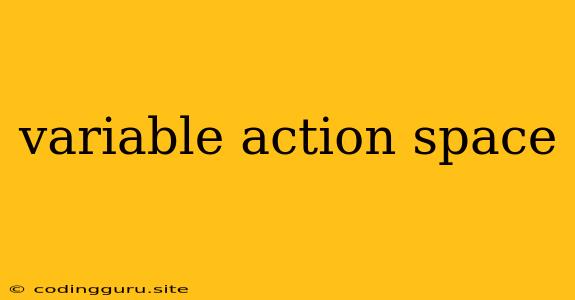Understanding the Action Space in Reinforcement Learning: A Key to Effective Decision-Making
In the realm of reinforcement learning (RL), the action space is a crucial concept that dictates the possible actions an agent can take within a given environment. To comprehend the importance of the action space, imagine a robot tasked with navigating a room. Its action space could include actions like moving forward, backward, turning left or right, and picking up objects. The agent's decision-making process is directly influenced by the actions available within its action space.
Defining the Action Space: A Spectrum of Possibilities
The action space can be categorized as either discrete or continuous, depending on the nature of the actions:
Discrete Action Space: This type of action space involves a limited set of distinct actions that the agent can choose from. Think of a game where the agent can only move up, down, left, or right. Each of these movements constitutes a discrete action within the action space.
Continuous Action Space: In contrast, a continuous action space allows the agent to take actions that fall within a range of values. Imagine controlling the speed of a car. The agent could choose any speed between 0 and 100 mph, resulting in an infinite number of possible actions within the continuous action space.
Importance of Action Space Definition: Guiding the Agent's Choices
The definition of the action space is paramount for several reasons:
- Action Selection: The agent's ability to effectively navigate its environment hinges on the actions available within its action space. A properly defined action space ensures that the agent can take relevant actions to achieve its objectives.
- Reward Function: The reward function, which guides the agent's learning process, is closely linked to the action space. The agent learns to take actions that maximize rewards within its defined action space.
- Algorithm Choice: Different reinforcement learning algorithms are designed to work best with specific types of action spaces. Choosing the appropriate algorithm depends on the nature of the agent's action space.
How to Determine the Action Space: A Practical Approach
Defining the action space requires careful consideration of the specific problem you're trying to solve:
- Identify the Agent's Capabilities: What actions can the agent physically perform within the given environment?
- Consider the Environment's Constraints: Are there any limitations or restrictions on the agent's actions within the environment?
- Analyze the Problem's Goals: What actions are necessary to achieve the desired outcome?
Examples of Action Spaces: Illustrating the Concept
Let's illustrate the concept of action space with some concrete examples:
- Chess: The action space in chess consists of all legal moves that a player can make, including moving pieces, capturing opponents, and castling.
- Robot Navigation: The action space for a robot navigating a room could include moving forward, backward, turning left or right, and stopping.
- Stock Trading: The action space in stock trading might involve actions like buying, selling, or holding specific stocks.
Conclusion: The Action Space - A Foundation for Effective RL
The action space plays a fundamental role in reinforcement learning by defining the range of possible actions an agent can take. It acts as a blueprint for the agent's decision-making process and influences its learning strategy. By carefully defining the action space, you equip your agent with the tools it needs to effectively interact with its environment and achieve its goals.
